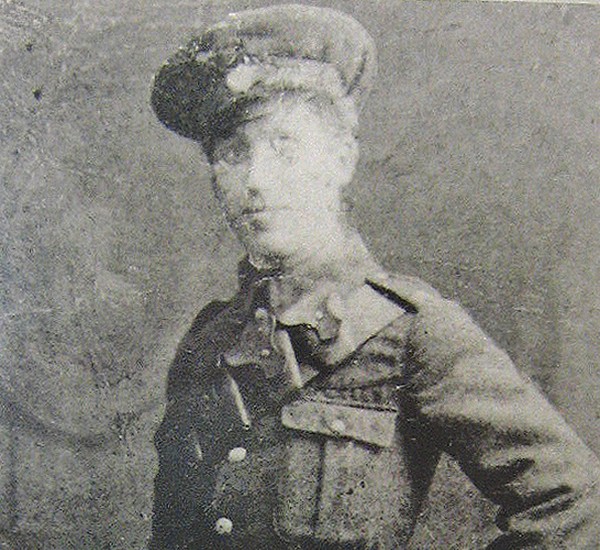
Pictured: The young Patrick Joseph Roe in uniform.
Patrick Joseph Roe was one of the youngest Volunteers attached to The Irish Volunteers C. Company, 3rd Battalion, Dublin Brigade, who played a part in the Battle of Mount Street Bridge.
Roe started a Fenian Group in Inchicore in 1912 with Liam Mellows, one of the founding members of the Volunteers. He went on to become a member of the Irish Republican Brotherhood in 1913.
The particulars of the “military operations… or services rendered” by Roe during the week of 23 to 29 April 1916, show that he was engaged in “Removal of Arms, First Aid Dressings, Etc from Michael Malone’s home, 37 South Circular Road to 6 Harcourt Street – Test mobilisation – General preparation for the Rising – Communications” and “on the run.”
He was also one of the four Volunteers who helped secure and defend 25 Northumberland Road during Easter Week, 1916, one of the bloodiest engagements of the Rebellion.
He was lucky to make it that far. When his Battalion arrived at Mount Street Bridge, he and another Volunteer, Michael Byrne, were sent by thier Commander, James Grace, to cover the gates of Beggars Bush Barracks at the junction of Haddington Road and Northumberland Road.
When they were there two men approached them, one elderly and one young. The elderly man tried to induce Roe to let him look at his rifle. Grace, with his bayonet fixed, ordered the man to stand back. He persisted and advanced towards Roe, trying to take the rifle from his hands. Grace put his bayonet to the man’s throat and ordered him to desist. The elderly man attempted to produce a weapon but was prevented from doing so by Grace.
Grace later discovered that the man, whose name was O’Connell, was a member of a pro-British territorial organisation, the GRs, who had instructions to rush and disarm Irish Volunteers when alone or in small numbers. Grace let him go but regretted it later and regarded it as a dereliction of duty.
Later that day Roe helped secure and defend 25 Northumberland Road. The Volunteers inside endured heavy sniper fire from Monday afternoon and throughout Tuesday. At about 12 o’clock on Tuesday night Lieutenant Malone called Grace aside and told him they could “not hope to win owing to the confusion caused by the GHQ countermanding order and also the overwhelming odds against them”. Additionally, the expected German aid had failed to arrive. The men were already exhausted as they had been involved in ongoing gun battles with the enemy since they took over the outpost.
At that point Malone decided that the two young volunteers, Roe and Byrne, who he believed were only sixteen or seventeen, should be sent away. This is disputed. Roe was in fact twenty at the time.
They were reluctant to go, rightly suspecting that the “dispatches” they were told to take to Malone’s house were an excuse to get them away from danger. Despite their protests Malone “gently but firmly” ordered them to take letters to his house on the South Circular Road and to wait there for further orders.
Grace recalls in testimony recorded by the Bureau of Military History (1913-1921) that at “about 2.30 am they crept out through the skylight and over the roofs, gloomy enough, because they had been told that under no circumstances were they to come back to No. 25.” They made their way to Malone’s house on the South Circular Road to “await orders”.
Of course those orders never came. At least not from Lieutenant Michael Malone, who “fell at his post” during the Battle of Mount Street Bridge.
Patrick Roe evaded arrest after the Easter Rising but was arrested and imprisoned during November, 1917, for illegal drilling. He was released after about 14 days following a hunger strike.
Undeterred, he continued in active service for the “cause”, serving with the IRA between 1920 and 1923 during the War of Independence, Truce Period and the Civil War.
By Jennifer Reddin



